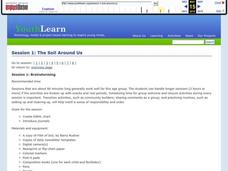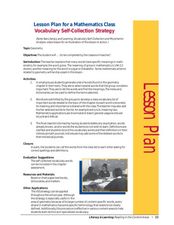Curated OER
Introduce: Comprehension Monitoring using About Trees
As scholars begin reading more difficult text, they need to acquire an arsenal of comprehension strategies. Here are few helpful ones to guide new readers through the informational text About Trees, which is linked here for...
Curated OER
Introduce Vocabulary: Into the A, B, Sea (Rose)
As budding readers learn about the ocean, they'll get practice with the alphabet and new vocabulary words (cling, nab, prey, slumber, and thrive) in context. Read Deborah Rose's book Into the A, B, Sea, which includes a...
Curated OER
Glossaries
Explore text structure with a focus on the glossary feature in informational texts. Learners read a brief introduction before examining a glossary from a text about plants. They reference it while completing four comprehension questions....
Curated OER
Using an Index - School-Home Links
In this home-school worksheet, 3rd graders review the use of an index. They read the definition at the top of the page, see an example of an index, and answer 4 questions based on the index. There is a place for the child and a parent to...
Lerner Publishing
Meet the Dinosaurs
Take your class of youngsters on a prehistoric adventure with this four-lesson series on dinosaurs. Accompanying the Meet the Dinosaurs books by Don Lessem, these lessons engage children in writing their own dinosaur books,...
Art Institute of Chicago
Send a Postcard
Using Claude Monet's On the Bank of the Seine as inspiration, young artists create their own postcards. During the lesson, learners discuss the techniques used in Monet's painting, as well as the woman in the painting, and...
Curated OER
"The Soil Around Us" Project
Young geographers collect samples of different kinds of soil to match to the soil terms in Barry Rudner's rhyming book Filet of Soil: dirt, mud, dust, soot, etc. They start a glossary for the project on index cards or large sheets...
Curated OER
Word Reference Materials
A class discussion on reference materials opens up a lesson on how to use these important resources. They discover that dictionaries, glossaries, and thesauruses are called word reference resources, and they practice using them. The...
Curated OER
Under the Sea - KWL Chart
Students create a KWL chart to start the discussion on ocean animals. They practice sorting the animals into their different classifications. They use indexes, table of contents and glossary to find information.
Curated OER
Vocabulary Self-Collection Strategy
Dedicate one or two class periods to creating a class glossary of geometry terms. Many geometry terms also appear in our every day vocabulary, but they have very different meanings. For example, the word gross in geometry is very...
Savvas Learning
Saxon Math 5/4
You'll never have to search for another worksheet again after downloading this extensive collection of Saxon math materials. With over 600 pages of example problems and skills practice exercises, this is a must-have resource...
Curated OER
School - Home Links: Parts of a Book
Parents or learning partners assist emergent readers with a School-Home Links worksheet. The children complete a matching activity about the parts of a book which include a table of contents, title page, and glossary. They match the word...
Curated OER
Under the Sea
Students identify and interpret that non-fiction books have features like a table of contents, a glossary, and an index, which can efficiently help them find information. They also identify how to narrow the search for information by...
Curated OER
Explanation
Walk your class through the process of writing an explanation using this resource. Learners often have to write a how-to explanation for such simple tasks as making a peanut butter sandwich. This presentation identifies key components of...
Curated OER
Under The Sea
For this resource lesson, young scholars use non-fiction books to research ocean animals. Students discover the many features of non-fiction books and how to use these features to help them conduct research. Young scholars then...
Curated OER
Reference Materials
Students discuss reasons to use reference materials, identify correct reference material to use for specific information, find answers to specific questions by locating information in encyclopedia, dictionary, atlas, almanac, glossary,...
Curated OER
Spelling Word Activities
In this spelling word worksheet, students practice reading and writing a list of spelling words which include words relating to the parts of a book such as prefix, appendix, index, contents, and bibliography. They use the word in the...
Curated OER
Computers: Copyright Law
Students visit various Websites to find information about copyright laws. Their research includes information about legal and ethical behaviors regarding Internet use. In addition, students complete online student activity sheets.
Curated OER
Flow Charts
Students explore the use of flow charts and cyclical diagrams. They discuss how to read the charts. Students produce a simple flow chart or diagram to explain a process. They investigate various methods used to present text.
Curated OER
Book Parts Matching Activity
In this book parts learning exercise, students match a set of definitions with their correct terms, list ways to care for books and use a word box to match statements to terms.
Curated OER
What is Rock Art?
Students complete the list of vocabulary words and terms and complete the Quick Facts section of a website and answer questions using 2 or 3 sentences from the worksheet about rock art. They then have their names sent to the website and...
Curated OER
The Dory Story
Students research the basics of Parliament and the government by using an internet site which has Dory the fish meeting different people involved in the parliment.
Curated OER
Sunlight and Warm Air
Young scholars examine the different ways heat can be felt. In this radiation and conduction instructional activity, students recognize that the sun radiates heat. Young scholars conduct three experiments to find how the sun warms...
Curated OER
Discussing Non-Fiction Texts
Discuss non-fiction texts and fact and opinion. Learners discuss the features of non-fiction text, identify how to distinguish fact from opinion, and list ways to display information, including graphs, charts, and diagrams. While this is...























